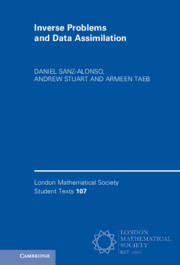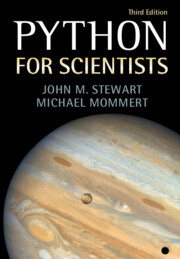Refine search
Actions for selected content:
2540 results in Computational Science
Exercises for Part II
-
- Book:
- Inverse Problems and Data Assimilation
- Published online:
- 27 July 2023
- Print publication:
- 10 August 2023, pp 164-170
-
- Chapter
- Export citation
11 - Particle Filter
-
- Book:
- Inverse Problems and Data Assimilation
- Published online:
- 27 July 2023
- Print publication:
- 10 August 2023, pp 144-152
-
- Chapter
- Export citation
6 - Markov Chain Monte Carlo
-
- Book:
- Inverse Problems and Data Assimilation
- Published online:
- 27 July 2023
- Print publication:
- 10 August 2023, pp 73-90
-
- Chapter
- Export citation
4 - Gaussian Approximation
-
- Book:
- Inverse Problems and Data Assimilation
- Published online:
- 27 July 2023
- Print publication:
- 10 August 2023, pp 49-58
-
- Chapter
- Export citation
Part I - Inverse Problems
-
- Book:
- Inverse Problems and Data Assimilation
- Published online:
- 27 July 2023
- Print publication:
- 10 August 2023, pp 1-2
-
- Chapter
- Export citation
9 - Optimization for Filtering and Smoothing: 3DVAR and 4DVAR
-
- Book:
- Inverse Problems and Data Assimilation
- Published online:
- 27 July 2023
- Print publication:
- 10 August 2023, pp 125-132
-
- Chapter
- Export citation
13 - Blending Inverse Problems and Data Assimilation
-
- Book:
- Inverse Problems and Data Assimilation
- Published online:
- 27 July 2023
- Print publication:
- 10 August 2023, pp 173-191
-
- Chapter
- Export citation

Inverse Problems and Data Assimilation
-
- Published online:
- 27 July 2023
- Print publication:
- 10 August 2023

Python for Scientists
-
- Published online:
- 27 July 2023
- Print publication:
- 17 August 2023
Bibliography
-
- Book:
- Numerical Methods in Physics with Python
- Published online:
- 30 August 2023
- Print publication:
- 20 July 2023, pp 671-676
-
- Chapter
- Export citation
5 - Zeros and Minima
-
- Book:
- Numerical Methods in Physics with Python
- Published online:
- 30 August 2023
- Print publication:
- 20 July 2023, pp 232-316
-
- Chapter
- Export citation
7 - Integrals
-
- Book:
- Numerical Methods in Physics with Python
- Published online:
- 30 August 2023
- Print publication:
- 20 July 2023, pp 453-565
-
- Chapter
- Export citation
Preface
-
- Book:
- Numerical Methods in Physics with Python
- Published online:
- 30 August 2023
- Print publication:
- 20 July 2023, pp xii-xvi
-
- Chapter
- Export citation
3 - Derivatives
-
- Book:
- Numerical Methods in Physics with Python
- Published online:
- 30 August 2023
- Print publication:
- 20 July 2023, pp 89-125
-
- Chapter
- Export citation
Contents
-
- Book:
- Numerical Methods in Physics with Python
- Published online:
- 30 August 2023
- Print publication:
- 20 July 2023, pp ix-xi
-
- Chapter
- Export citation
2 - Numbers
-
- Book:
- Numerical Methods in Physics with Python
- Published online:
- 30 August 2023
- Print publication:
- 20 July 2023, pp 31-88
-
- Chapter
- Export citation
Appendix A - Installation and Setup
-
- Book:
- Numerical Methods in Physics with Python
- Published online:
- 30 August 2023
- Print publication:
- 20 July 2023, pp 657-657
-
- Chapter
- Export citation
8 - Differential Equations
-
- Book:
- Numerical Methods in Physics with Python
- Published online:
- 30 August 2023
- Print publication:
- 20 July 2023, pp 566-656
-
- Chapter
- Export citation
6 - Approximation
-
- Book:
- Numerical Methods in Physics with Python
- Published online:
- 30 August 2023
- Print publication:
- 20 July 2023, pp 317-452
-
- Chapter
- Export citation
4 - Matrices
-
- Book:
- Numerical Methods in Physics with Python
- Published online:
- 30 August 2023
- Print publication:
- 20 July 2023, pp 126-231
-
- Chapter
- Export citation
